|
Volume XXXII-XXXIII - 2001/2002
Oregon's Two Largest, Deepest, Bluest, Purest Lakes: A Comparison
By John Salinas
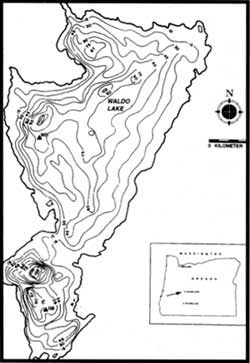
Bathymetric map of Waldo Lake with depth contours in meters.
|
The Cascade Range holds lakes unmatched in the world. In comparing
two of its more prominent lakes, Crater Lake in the southern part of
Oregon and Waldo Lake in the central part of the state, there are some
superficial similarities but also distinctive differences. The latter
become readily apparent as each lake gradually becomes more familiar to
visitors, though the significant attributes of each lake can be set
apart from most other lakes anywhere in the world. As exceptional
oligotrophic (nutrient-poor) bodies of water, Crater Lake and Waldo Lake
are well worth the cost and effort to ensure their protection "for all
people, for all time."
Locations
Waldo Lake is situated about 190 km south-southeast of Portland,
Oregon, at an elevation of 1650 meters above sea level. It is 9.6 km
long and has a surface area of 25.5 square kilometers. Its bottom is
gently sloping to a maximum depth of 128 meters on the lake's western
side. Water received into the lake falls on an area about twice as large
as the lake itself. Soils are organically poor and well drained, with
bedrock less than two meters below the pumice and rounded boulders. The
forest surrounding the lake contains lodgepole pine, western white pine,
mountain hemlock, western hemlock, Douglas fir, noble fir, true fir, and
Engelmann spruce. Management of the area is the responsibility of the
U.S. Forest Service staff on the Willamette National Forest. The western
shores of the lake adjoin the Waldo Wilderness Area. The northern
tributaries of the Willamette River's middle fork flow from the
northwest of Waldo Lake.
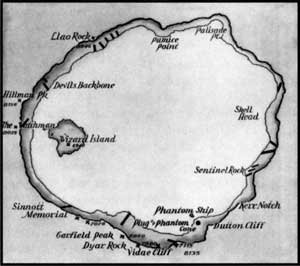
Crater Lake with key features around the rim.
|
Crater Lake is located 130 km northeast of Medford, Oregon. Vertical
cliffs surround the lake and are remnants of the collapsed Mount Mazama
volcano. The lake basin is enclosed in a caldera and composed of varying
amounts of andesite, pumice, rhyodacite and other igneous or volcanic
materials. The adjoining forest includes mountain hemlock, Shasta red
fir, lodgepole pine, western white pine, and whitebark pine. The
National Park Service manages Crater Lake. Most of this national park
area is de facto wilderness except for several road corridors and
developed areas devoted to administrative functions and visitor
facilities. No known surface streams flow out of Crater Lake.

Plate tectonics relative to the Pacific Northwest.
|
Geological settings
At the grandest scale, the High Cascades of Oregon are a product of
plate tectonics. As plates of the Earth's crust subduct off the Oregon
coast, crustal material melts and these magmas are found again on the
surface as volcanoes. Waldo Lake rests in an area of the High Cascades
in a basin composed of basaltic andesite that flowed about 750,000 years
ago. It was produced from a group of volcanoes named Waldo Mountain,
Cupit Mary Mountain, Fuji Mountain, Mount Ray and The Twins. These lavas
however, have been reworked by glacial ice. The area is covered with a
fine powder left by ice as it grinds against rock. The glacier that
excavated Waldo Lake moved in a northward direction, originating in the
highlands between Mount Ray and Fuji Mountain.
Material pushed by a glacier is called a moraine and can sometimes
provide barriers for a lake to form. Ice, like water, flows downhill. At
the time the Waldo Lake basin was formed, a geologic fault existed just
along the west edge of the present lake. The glacier mostly flowed
north, but a tongue of ice headed west into the Black Creek drainage as
the glacier gained height. It followed the north-south trending fault,
marking the western edge of the High Cascade graben (a depression
bounded by faults on at least two sides). The glacier did the actual
work of excavating the lake, but the fault controlled where that work
would take place. If the main glacier had headed into the Black Creek
drainage, there would be no separation of the lake basin from the creek
drainage and Waldo Lake would not exist. Waldo Lake filled the basin as
the glacier melted, suggesting that this water body is 10,000 to 12,000
years old.
Crater Lake is located in the caldera of a collapsed volcano, Mount
Mazama. The mountain is also a part of the High Cascades, but in
southern Oregon. The overlapping shield and stratovolcanoes that today
contain Crater Lake began to be formed about 420,000 years ago. About
7,700 years ago, in a cataclysmic eruption that may have lasted for
days, the volcano spewed 50 km3 of ash
and pumice into the air covering much of the Pacific Northwest. The
magma chamber feeding the eruption was eventually depleted of most of
its contents so it could not support itself and collapsed. This feature
is termed a caldera. What is unique about this feature is that it
contains the deepest caldera lake in the world.
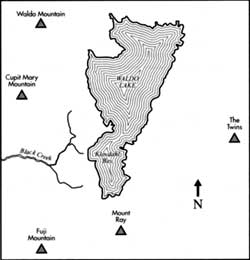
Geographical features in the vicinity of Waldo Lake.
|
The collapsed volcano continued to erupt, sealing the floor of the
caldera. Two cinder cones were formed on the caldera floor, with one
(Merriam Cone) being formed below the lake's surface and the other
(Wizard Island) forming above the surface. The lake began to form within
500 years of the mountain's collapse. Heat from Mount Mazama's magma
chamber still affects the water of Crater Lake. Not that the heat is
enough to alter the surface temperature of the lake, but water
circulates down toward this heat reservoir and returns containing
chemicals from the geothermal sources located below. Rock on the lake
floor is altered by this hot water, and this circulating water
chemically alters the lake. This makes Crater Lake fundamentally
different from other lakes in the High Cascades.
Physical aspects of the two lakes

Equipment for measuring light in Crater Lake, 1940.
NPS photo.
|
Both Waldo Lake and Crater Lake have very small watersheds. Crater
Lake occupies a little more than 78 percent of its watershed, meaning
that most of the rain and snow input falls directly into the lake from
the sky. Waldo Lake occupies about 32 percent of its watershed,
suggesting that almost two thirds of the precipitation falling in the
Waldo watershed arrives indirectly, by way of land. Waldo Lake would
take 30 years to fill with water, given present rainfall and the
evaporation rates. That period of filling for Crater Lake would be
somewhere between 200 and 300 years. Water falling as rain or snow
allows these lakes to exist, but water quality is also affected by the
particular characteristics of the respective lake basins.
Water levels of both lakes have remained relatively constant due to
three processes: inflow, outflow, and evaporation. The inflow at Crater
Lake is almost totally precipitation. In 1985, when the author helped to
survey the caldera walls for springs, he was astounded to find 51
surface water inflows into Crater Lake. Few of these springs flow
throughout the year, though some include wonderful waterfalls that
sometimes drop directly into the lake. Trying to collect water from this
type of spring has led to my being 'soaked to the bone.' Waldo Lake has
no creeks flowing directly into it throughout the year. Ground water,
however, flows into the lake thereby offsetting the lake's outflow.
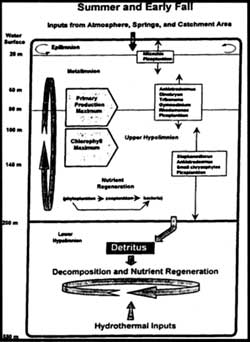
Simple model of the vertical distribution of selected
physical, chemical, and biological components of the limnetic zone of
Crater Lake. Curved arrows in the epilimnion indicate a zone of
circulation and mixing. Graphic courtesy of Gary Larson.
|
Swimming in Waldo or Crater Lake is a thrilling experience, largely
because of their temperatures. The warmest surface temperature recorded
in Crater Lake is 19.2°C, but the maximum some years does not get
above 15°C. The same surface temperatures may be measured at Waldo
Lake. A lake's upper stratum near the surface (called the epilimnion) is
the warmest layer because lakes absorb heat from the more direct
sunlight during summer. Just below this warm layer is a layer of water
that changes from the warm surface to the cooler deep water. This
transition zone is called the metalimnion, or thermocline. Both lakes
share similarities in this zone, one beginning at about 20 meters in
depth and extending to roughly 50 meters. There is low heat absorption
below 50 meters, so temperatures remain between 4 and 6°C at Waldo.
This deep-water zone is termed the hypolimnion and at Crater Lake the
temperature remains between 3.5 and 3.7°C. It is in this zone where
the two lakes display a marked difference. Some geothermal heat enters
Crater Lake from the caldera in which the lake rests, so the water of
Crater Lake increases slightly in temperature below 300 meters.
As winter approaches, lakes begin to cool. The cooling of surface
water causes this layer to increase in density and sink. The sinking and
mixing with deeper water allows chemicals deep in the lake to become
available to plants and animals in the shallower parts of the lake, thus
a fall 'bloom' may occur. As the lakes cool further, ice may form. It is
just as unusual for Waldo Lake to not freeze in a winter season as it is
for Crater Lake to freeze. The single difference here is depth. Crater
Lake is over eight times deeper (using its average depth) than Waldo
Lake. This great reservoir of water (and heat) can keep the surface of
the lake from freezing. As the surface of a lake cools, it becomes
denser—though sinking cool water is offset by rising warmer water.
At Crater Lake this can go on all winter. The rising 'warm' water at
Waldo Lake does not carry the same amount of heat, so the lake will cool
below the freezing point of water.
Table I. Comparative Features of Crater Lake and
Waldo Lake
|
|
CRATER LAKE |
|
WALDO LAKE |
|
| Elevation |
1882m | 6170ft |
1650 | 5410 ft |
| Maximum Depth |
589m | 1930ft |
128 m | 420 ft |
| Mean Depth |
325m | 1070ft |
39 m | 128 ft |
| Surface Area |
53.2 km2 | 20.5 mi2 |
25.5 km2 | 9.85 mi2 |
| Volume |
17.3 km3 | 4.15 mi2 |
0.949 km2 | 0.23 mi3 |
| Annual Precipitation |
1.71 m | 67.3 in |
1.8 m | 70.9 in |
| Water Retention Time (yrs) |
150 | 150 |
30 | 30 |
| Length |
9.7 km | 6.0 mi |
9.6 km | 6.0 mi |
| Width |
8.2 km | 5.1 mi |
4.3 km | 2.7 mi |
| Watershed Area |
14.6 km2 | 5.6 mi2 |
53.5 km2 | 20.7 mi2 |
|
| Watershed (%) |
78.5 |
32.3 |
| Surface Outflow |
None |
North Fork, Middle Fork, Willamette River |
| Nitrate ion (mg/L) |
1 - 17 (low on surface) |
0.2 |
| Ammonia (mg/L) |
2-4 |
2.4 |
| Total Phosphorus (mg/L) |
22 - 28 |
2.9 |
| Dissolved Phosphorus (mg/L) |
11-15 |
0.9 |
| Conductivity (mS/cm) |
116 |
3.5 |
| Alkalinity (mg/L) |
25 - 31 |
0.58 |
| Sulfate ion (mg/L) |
10 |
0.11 |
The two lakes appear blue because of the interaction of sunlight with
the water. A lake will appear colored due to materials suspended in the
water (mud, algae), the reflection of sky or clouds, and because of
certain colors in the spectrum of sunlight being absorbed by the water.
These two lakes have very little suspended material in the water, and so
appear clear. Water around the shore appears clear with rocks and sand
easily visible. As the water gets deeper, the bottom appears green or
blue green the lake absorbs the red, orange, yellow colors of sunlight
more readily than the green and blue colors. If the water is more than
60 meters deep, the water appears blue.
Research staff at Crater Lake purchased an underwater spectral
irradiometer in 1995. This device measures the light spectrum reaching
down to 200 meters in the lake. Red light is quickly absorbed, but the
lake transmits blue light of precisely 478 nanometers in wavelength in
the deep water. This is the color of Crater Lake that one sees. The
irradiometer has not been used in Waldo Lake, but is expected to return
similar data. Light in a lake or an ocean eventually becomes so low with
increasing depth that one would admit that it was dark. When one
investigator took a submarine to a depth of 450 meters on Crater Lake
floor, however, he turned all the electric lights off and was able to
"see" a slight amount of sunlight from the surface. This is the mark of
a lake with incredibly clear water.
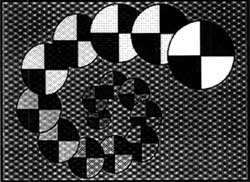
Artist 's rendition of a Secchi disk on its descent
into the water. Graphic courtesy the author.
|
The simplest test of clarity of a lake is to use a "pie plate on a
string" or, officially, the Secchi disk. This 20-cm diameter metal or
weighted plastic disk is usually quartered black and white. It is
lowered into a lake and the depth at which it disappears is recorded.
The Secchi clarity depth at Crater Lake was recorded in June of 1997 at
43.3 meters. At Waldo Lake the deepest Secchi depth was measured to be
41.3 meters in July 2001. This "eyeball" test of a lake's water clarity
greatly depends upon the sky conditions and the lake surface. If clouds
obscure the sun or the lake is ruffled by wind, the disk will
prematurely disappear. To put this test in perspective, many lakes with
large watersheds seldom have Secchi depths of greater than 10 meters.
Muddy water may have a Secchi depth of less than one meter. In this
case, two world-class lakes are being compared and can be seen to be
very similar in clarity. It should be noted, however, that Waldo Lake
does not currently host a full-time research effort while Crater Lake
does. It is very difficult to record the best Secchi clarity depths on a
part-time basis. Visiting the lake for a day or two each month lessens
the chances that the sky and lake surface conditions will be 'perfect'
for viewing the disk.
Management concerns
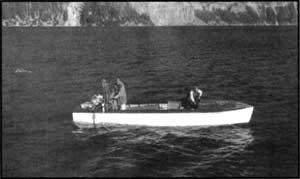
Research on Crater Lake in August, 1960. NPS photo
by Jack Boucher.
|
Crater Lake attracts an average of 500,000 people each year. Roughly
10 percent of these visitors walk down a relatively steep trail that
serves as the sole access point to the lake in order to swim, go fishing
or take the tour boat around the lake. Impacts to the lake from visitors
are relatively minimal as far as is known, but long term trends or
effects are still imperfectly understood. Waldo Lake attracts fewer
visitors, but the lake is 'at their campsite.' Visitors can park a few
feet from the lake, swim, launch a boat or camp. The 14 mile gravel road
to Waldo Lake was paved in 1964 and visitor use increased dramatically.
By 1982 visitor-use days reached 50,000 and that figure climbed to
103,000 visitor-use days by 1998. Waldo Lake appears to be more
sensitive and at risk of being more impacted than Crater Lake, though
restroom facilities near the shore are being replaced by composting
toilets and more rustic campgrounds are being eliminated around the
lake.
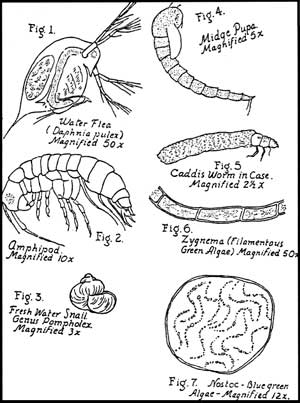
Biota of Crater Lake. From Nature Notes, Vol. VIII,
No. 2, Aug. 1935.
|
Crater Lake has enjoyed a National Park Service sponsored research
program since 1982. Between 1978 and 1981 some limited support helped to
start a lake monitoring and research program. Crater Lake now has
several full-time biologists and ecologists actively collecting data and
working on research questions with an infrastructure of offices and
laboratory facilities. A boat house on Wizard Island allows for research
activities in winter as well as temporary living quarters and laboratory
space. The two research boats on Crater Lake are similar to the research
vessels used on Lake Tahoe and are versatile enough be employed in a
wide range of studies.
Waldo Lake is not so well supported, though the Forest Service has
stretched its limited watershed monitoring funds. The Oregon Department
of Environmental Quality has also funded some limited research on the
lake. There is no full-time limnologist or ecologist assigned to the
monitoring efforts at Waldo Lake, though the writer has enjoyed some
support for his involvement at Waldo Lake since 1986. The Forest Service
has no boat, laboratory, nor equipment to monitor Waldo Lake and so must
contract with others to do this work.
It should be said a research program involves measuring a wide array
of chemical and biotic indicators for these two pristine lakes.
Interested readers should examine the accompanying table for some of the
indicators used as a basis for comparing Crater Lake with Waldo Lake.
The references below are included for those wanting more specific
information about past and present studies.
References
Ellen T. Drake, et al. (eds.), Crater Lake: An Ecosystem
Study. San Francisco: Pacific Division of the American Association
for the Advancement of Science, 1990.
Daniel M. Johnson, et al., Atlas of Oregon Lakes. Corvallis,
Ore.: Oregon State University Press, 1985.
James F. LaBounty and Douglas W. Larson (eds.), Lake and Reservoir
Management (journal issue devoted to Waldo Lake) 16:1-2 (2000), pp.
1-150.
James E. LaBounty and Gary L. Larson (eds.), Lake and Reservoir
Management (journal issue devoted to Crater Lake) 12:2 (1996), pp.
221-310.
John Salinas studied lakes throughout Oregon after being inspired
by Crater Lake as a seasonal naturalist. He teaches science at Rogue
Community College in Grants Pass, Oregon.
|

